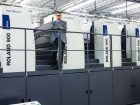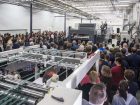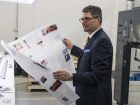
Friesens of Altona, Manitoba, began to install its new 73-inch manroland R900 HiPrint XXL perfecting press in March on its way to building one of the world’s most-efficient pressrooms (originally published in PrintAction September 2015).
The town of Altona in southern Manitoba holds slightly more than 4,000 people in an economic landscape primarily driven by farming- and agriculture-based businesses, as well as the manufacture of books. In early March, the town became home to one of the world’s three 8-colour, 73-inch manroland R900 HiPrint XXL perfecting presses, which Friesens Corporation is leveraging for short-run book work.
Most presses of this size are saved for the packaging sector, where perfecting is usually not needed to print on both sides of the substrate. Of course, Friesens’ press also required significant inline colour management tools to deal with a massive sheet that will often hold 64 unique and different pages at one time. The company is well known by other printers for its near-spotless pressroom and by North American publishers for its ability to print short-run, colour-intensive works of art.
“I never want to lose the underdog mentality that has existed as part of the fabric of this company for 107 years. We are in the middle of nowhere, but that just breeds ingenuity and hard work,” says Curwin Friesen, CEO of Friesens Corp., which provides an ownership model for its approximate 600 employees, tying the highly respected book manufacturer even closer to the community.
When the R900 arrived in Altona by dozens of tractor-trailers, it was too large for Friesens’ shipping bays and the company needed cut a massive hole into the side of the building for direct entry into what would become a newly configured pressroom. Installed, the press is approximately 100 feet long and weighs half a million pounds. Before commissioning the press in July, celebrated with a ribbon-cutting ceremony with hundreds of staff members and around 75 dignitaries, Friesens conducted three and half months of set up and testing.
Form efficiency
The decision to go with the R900 was made a little more than a year ago, after first discussing the possibilities of moving to very large format technology at the drupa 2012 trade show in Germany. It would be a challenge to handle such a large sheet and perfect it without marking, which can be a technical struggle even with 40-inch perfectors.
“It is very much an efficiency play and a progression from where we have moved in our history,” says Friesen. The company began working 8-page signatures, four pages on each side of a sheet sent through the press twice, drying twice before folding. When press technology improved the crew moved to a machine printing 16-page signatures, again twice through. “In the late-80s, we went to 50-inch format when others were on 40-inch format and that allowed us to go to a 32-page, 8 ½ x 11 signature.” The press sheets still traveled twice through the press, but the company’s 50-inch machines were printing a 64-page children’s book with just two sheets and four make-readies.
The new 8-colour, 73-inch manroland R900 perfector allows Friesens to print a 64-page children’s book with one sheet and one make-ready. The relative efficiency of the new press, over the 50-inch machines, is increased by anywhere from 300 to 400 percent, with a more precise number expected after more time with the R900 reveals figures like wastage, press speed, and finely-tuned make-ready – with the latter number ending up slightly more than a quarter of 50-inch machine make-ready.
“There are hardly any book manufactures in North America who are running 50s and almost none overseas. It is basically a 40-inch world and we live in the 50-inch world and now we are trying to live in the 73-inch world,” says Friesen. “Is it more efficient – absolutely. Are we excited about the productivity numbers we are starting to see – you bet we are. Since the ribbon cutting, every week is getting better and our crews are getting more familiar with it, more comfortable.”
Pressroom build
The multi-million-dollar technology investment included the purchase of a massive Maxson Automatic Machinery Co. precision sheeter, because Friesens has traditionally converted its own stock, which now sits about 15 feet in front of the press.
A new large-format platesetter – about 65 feet long in its own controlled positive air space – is also close by and integrated with robotics to move the massive 73 x 50-inch plates – in addition to 50-inch plates – through the imaging process, before a specialized conveyor is wheeled about 10 feet to modified catwalk rails where crews finally touch the plates for mounting on the R900.
The manroland R900 configuration is also unique because Friesens’ management decided to maintain its bindery set-up for 32-page signatures, resulting in an inline slitter system integrated with the new press, as well as the continuing interest in 50-inch machines. “One of the other things unique about this press is that we put an engineered pit underneath it, so we have better access and that is not done anywhere else in the world,” says Friesen, noting how much the company’s mechanics were involved in the R900 investment project.
“The beauty of it is that we were starting from scratch and our goal was to create the most-efficient pressroom in the world and everything mirrors this mindset,” says Friesen.
Market matters
Despite its massive size, the efficiency of the press and pressroom allows for incredibly short runs of around 4,000 books and up, with an ideal range at around 10,000. “We are a short-run book manufacturer that is what we specialize in within our book division,” says Friesen. The company already produces long runs that may measure around 100,000, but the R900 also presents a new opportunity to provide sheetfed press quality on some lower-end Web offset press speeds.
“Books are not DVDs. Books are not music. Books are different. As we see with business cards, some players in the market believe that business cards are going to be around forever and they certainly do not seem like they are going away,” says Friesen. “One large player has also used large format on short-run business cards to change the game.”
Friesens generates approximately 55 percent of its revenue from the U.S., which Friesen has noticed picking up because of the lower dollar, and 45 percent domestically. Based on various avenues of research, he notes the book market has been very stable for the past five years, to the point where independent bookstores are growing for the first time in a decade. Friesen explains it appears the concentration of e-readers has hit a saturation point in North America. “E-books have their niche and have an important role in the book business, but not the only role,” he says. “Publishers see that sales are bearing that out and so we continue to believe there is a strong future for books.”
Friesen describes one recent report from Deloitte based on polling a sample of 18 to 24 year olds who exhibited a strong propensity toward printed books. “Despite the fact that they live in a digital world they still like print for a bunch of reasons.” Friesen is also noticing more on-shoring of book printing, relating that many publishers are returning to North American printers instead of having the work done in China.
The trend is driven by much busier Chinese ports and the need for shorter turnaround times, as well as more preference to print lower run totals; for example, two 5,000 jobs instead of 10,000 at once. Friesen explains it is not in a printer’s best interest to print 10,000 books and have the publisher only sell 2,000. “Is China still going to be a big printing force – absolutely – but if five percent of that business returns, or 10 percent, on a billion-dollar industry, that is significant.”
In addition to its strong roots in yearbook production, typically with runs measured in the hundreds, self publishing is a growing sector for Friesens, through its FriesenPress division that sells packages – potentially with editing, copywriting, designing and proofreading services in addition to printing – that might cost around $3,500 run on digital presses instead of $15,000 via litho.
“We believe that we are going to be in books for a long, long time and if we are going to be in books then we better be geared up for it and not just dabbling,” says Friesen, projecting a relatively stable market for at least the next decade. A little more than five years ago, however, Friesens’ managers were tasked with expanding the company’s interest in packaging, which resulted in think4D, consisting of around 40 employees.
After purchasing a Toronto company and related patents, and investing a few million into R&D, think4D is a unique operation in the world that marries thermoforming and printing. “We found thermoforming and print were two different worlds,” says Friesen. “With some of the technologies we were researching, we thought that we could combine those worlds. Why not print on the plastic and then thermoform that piece out of the plastic already printed.”
This innovation in packaging is built from a culture that developed over decades by leveraging technology to innovate the process of manufacturing books. “It isn’t always just the numbers we paint on press at times. There are efficiencies and robotics and workflow… yet the product we are producing is an art piece, often at the end of a creative chain.”
Print this page


